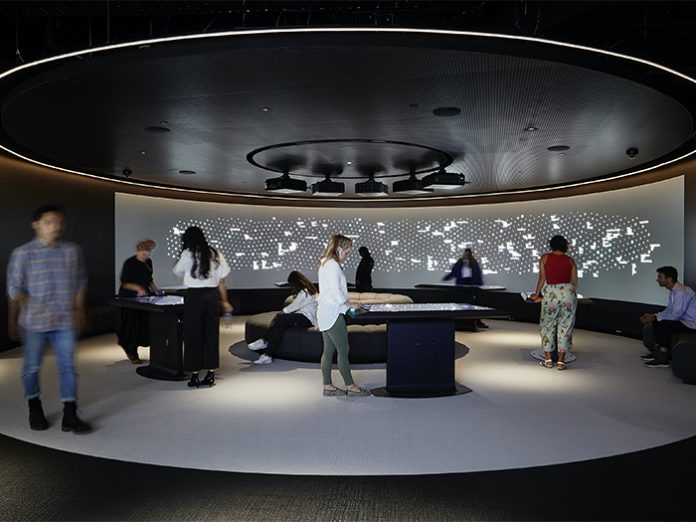The world’s first feature film was made in Australia, so it’s no wonder one of the nation’s premier museums is dedicated to the art of the moving image. ACMI, Australia’s national museum of screen culture located in Melbourne, celebrates the nation’s robust history in the medium – including film, television, video games, and moving image artwork.
Recently, the museum underwent a renovation that completely overhauled its centerpiece exhibition design – and its AV system – to allow visitors to take a journey through Australia’s history of moving images. By utilizing robust, immersive, and interactive AV, the exhibition, titled The Story of the Moving Image, advances through time – from shadow play to the films that shaped Australia’s cinematic landscape. The exhibition includes Games Lab Presented by Big Ant Studios, where AAA titles sit alongside a curated selection of locally made indie games, and a section dedicated to the power of citizen journalism.
And while the museum is largely focused on the “image” component of its name, the need for thoughtfully placed audio throughout the space is critical – requiring hundreds of audio feeds across the gallery space. To make that much sound work, the ACMI designers relied on Audinate’s Dante.
“Traditionally, the space has been known to be a bit cacophonous,” said Greg Turner, a consultant working with ACMI. “Because of that, we knew from the start it was going to be critical that we had tight control over all of our audio signals. With the redesign we’ve installed hundreds of displays in the space, so how do we make sure we’re managing hundreds of audio signals as well? The obvious answer from the start was Dante.”
Dante is the de facto standard for digital audio networking, and distributes hundreds of uncompressed, multi-channel digital audio channels via standard Ethernet networks, with near-zero latency and perfect synchronization. Dante allows audio, control, and all other data to coexist effectively on the same network. Additionally, using Dante as opposed to traditional networking allows for a reduction in electromagnetic interference – something important to ACMI as it is located nearby a Melbourne train line.
“ACMI has created a soundscape that requires both localized sound as well as sound that exists as a background across the entire gallery space,” said Michael Cartmel, integrator at Lumicom Pty Ltd. and lead installer on the ACMI project. “When you consider all the endpoints in this system, it would be horrendous to try and do this without Dante. You’d have an impossible number of speaker cables and you’d be hard pressed to pinpoint what cable was for what speaker.”
But with Dante, Cartmel said, the process was not only easier, but also more elegant. Each endpoint in the system is connected to the network and sent to a virtual matrix switch. The system then relies on a Dante-native QSC Q-SYS Core 510i to provide both DSP and control of the system through its Q-SYS software platform.
Endpoints on the system are typically speakers – the museum uses Yamaha speakers and Dante-native amplifiers across the space – however, oftentimes an input is added by way of a microphone or a localized piece of video. In those cases, where Dante isn’t natively integrated into an endpoint, the museum uses Dante AVIO adapters.
Available for analog input or output, Dante AVIO Adapters allow users to connect nearly any piece of gear with an audio signal to a Dante-connected system — delivering the interoperability, performance, and scalability that only networking can bring.
“The video game consoles, for example, aren’t Dante native,” Cartmel said. “But it’s no problem. We put AVIO adapters on them and quickly added audio on the network. It’s perfect.”
Cartmel said a similar approach is used in areas where individuals can craft their own soundscapes using inputs such as microphones, instruments and music software. The system takes the input generated by the user and makes it Dante-native immediately with the AVIO adapters.
And, most importantly, the museum is able to bring all these unique endpoints together in a streamlined system featuring customized sound in every location. This provides an immersive experience tailored precisely to where an individual is in the museum, or what exhibit they might be interacting with.
“Despite the architectural challenges presented by ACMI’s centerpiece exhibition The Story of the Moving Image, Dante has allowed us the flexibility to adapt our immersive soundscapes to suit the space,” said ACMI Renewal Project Manager Evan Davies. “It has allowed us the freedom to move sound anywhere throughout the exhibition, tweaking on the fly and letting us blend the soundscapes with the 100 or so other sound sources also present in the system.”
“With this system we have the ability to take every audio signal we’re using in the space and use it to specifically fit in the overall soundscape,” Cartmel said. “It is an incredibly flexible system thanks to the power of putting audio on the network with Dante.”





